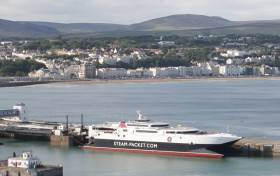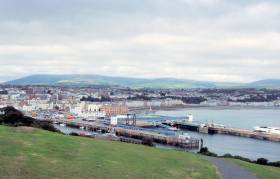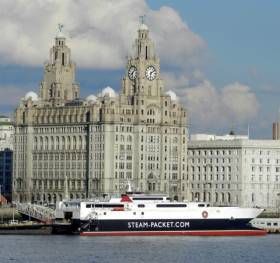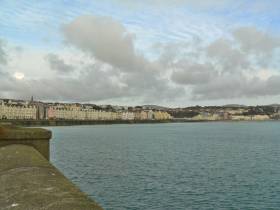Displaying items by tag: Isle of Man
Manx & NI Lifeboats Assist Broken Down Angling Vessel
#RNLI - Ramsey RNLI on the Isle of Man launched its all-weather lifeboat Ann & James Ritchie yesterday afternoon (Wednesday 23 May) to render assistance to a day angling vessel with three people on board.
The 21ft vessel had broken down seven miles south-west of Burrow Head in the Irish Sea. In fair weather conditions and a slight sea, the Ramsey lifeboat with acting coxswain Ali Clague at the helm located the stricken vessel at 1.20pm, 70 minutes after launch.
A tow was safely established, and it was advised by Belfast Coastguard that the lifeboat should bring the vessel towards Donaghadee on the Ards Peninsula.
Donaghadee’s all-weather lifeboat Saxon was tasked to rendezvous with the Ramsey crew and the two lifeboats met approximately one mile to the west of Mull of Galloway lighthouse at 3.25pm where the tow was passed.
Fastferry Dublin and Belfast Seasonal Services Resume to Isle of Man In Advance of Easter Break
#FerryNews - This morning the first Dublin-Isle of Man sailing for season 2018 began with fastferry Manannan departing on time at 10.45 in advance of the Easter Bank Holiday weekend, writes Jehan Ashmore.
The fast ferry service taking 2hrs 55mins is operated by the Isle of Man Steam Packet Company. Manannan made an arrival to the Irish capital having departed on the outward leg from Douglas at 07.00.
In recent days Manannan also resumed daily operated Isle of Man sailings to Liverpool and yesterday began serving through Belfast. These sailings compared to the Dublin route are marginally shorter taking 2hrs 45mins on the Ulster link.
On occasions when conventional ropax Ben-My-Chree provides these services, the sailing times are longer on both the Irish routes.
The Steam-Packet has more than 900,000 offer seats available during the season. Company Chief Executive Mark Woodward said: ‘The return of our fast craft Manannan is always an exciting and busy time for us, and we are looking forward to welcoming our passengers on board. It is always great to see a combination of Island residents heading off on their travels, along with curious visitors on their way to discover our special island!’
Manannan can take 200 vehicles and 850 passenger and crew. There are a variety of seating areas, including two cinema lounges, a large bar area at the stern and the Coast-to-Coast cafe that offers a wide selection of food options.
On the upper deck is the enlarged skylounge providing accommodation for the Niarbyl Reserved Lounge, the Manannan Premium Lounge and the Manannan Executive Club.
Isle Of Man Approves Millions For Port Development To Attract Cruise Liners & Yachts
#IsleOfMan - A new deepwater berth for visiting cruise liners is on the cards for the Isle of Man, following the green light for an £80 million (€91.1 million) project to develop the Irish Sea island’s ports.
IBI Plus reports that the Tynwald parliament has approved the expenditure over the next three years in order to ensure that “island facilities are robust, modern and practical for both industry and leisure,” according to a government spokesperson.
The focus of investment will be at Victoria Pier in Douglas, where £11 million (€12.5 million) will be spent on upgrading facilities to allow cruise liners of up to 240 metres in length to berth in the port instead of anchoring in Douglas Bay — and potentially boosting visitor numbers into the tens of thousands.
Elsewhere, existing marinas in Douglas and Peel are inline for significant investment. IBI Plus has more on the story HERE.
Rare Sight Of Large Minke Whale Pod In Irish Sea ‘Feeding Frenzy’
#MarineWildlife - An “extremely rare” pod of minke whales has been sighted in the Irish Sea off the Isle of Man this week.
According to BBC News, the pod comprising as many as 20 minke whales was engaged in a “feeding frenzy” as seen by members of Manx Whale and Dolphin Watch on Wednesday (13 September)
The marine wildlife species is a regular visitor to the waters around the Isle of Man, but sightings are usually of solitary adults or small pods.
It’s believed that spawning herring have attracted them in much greater numbers. BBC News has more on the story HERE.
In other marine wildlife news, the Irish Whale and Dolphin Group’s AGM takes place on Sunday 8 October at the Middle Country Café in Cloughjordan, Co Tipperary. Details are available from the IWDG website.
#Liverpool - Essential works to be carried out at the Liverpool landing stage costing £540,000 has been agreed by the Isle fo Man Steam Packet Company so to safeguard services to the city for three more seasons.
The major investment is necessary to ensure that fast craft services can continue to operate between Douglas and the heart of Liverpool until the end of 2019, when a new berth will be required.
The contract to use the landing stage at Princes Parade was originally due to expire on 31st December 2016 and owner Peel Ports had indicated Steam Packet Company operations would need to relocate elsewhere. The landing stage was described as ‘time expired’ and too old to maintain but, following a request from the Steam Packet Company, Peel Ports reviewed the condition of the landing stage and identified its lifespan could be extended by three years if extensive essential works are carried out later this year.
As part of the three-year contract extension the Steam Packet Company has agreed to reimburse Peel Ports for the works, which will cost £540,000, securing the popular city centre berth until the end of Manannan’s 2019 season.
There will be no request for the Isle of Man Government to contribute and passenger fares will not be increased to pay for the investment. Scheduled services will not be disrupted when the required remedial works are carried out.
Steam Packet Company Chief Executive Mark Woodward said: ‘The future of the existing landing stage has been in doubt for some time, so we are pleased to be able to give our passengers certainty, at least in the short term.
‘As a business with its sole focus on providing services for the Isle of Man, we know that maintaining a Liverpool route is vitally important to many people in the Island as well as to developing the visitor market. We have now secured an immediate solution, but new facilities will be required longer term.
‘While we may have preferred to remain at Princes Parade, as it is a central location which is convenient for passengers, that is not viable longer term as Liverpool City Council wants to create a dedicated cruise terminal in this area, preventing our services berthing there.
‘Birkenhead 12 Quays, used by Ben-my-Chree during the winter, is not suitable for fast craft, there are currently no other Merseyside berths available and using the Liverpool Dock system would add about 45 minutes to journey time, negating the benefits of a fast craft service.’
He continued: ‘In 2016 Tynwald agreed the Department of Infrastructure could purchase land at Prince’s Half-Tide Dock with a view to creating a berth there. That facility will take time to complete, but our significant investment to retain the current landing stage for a further three years gives Isle of Man Government the time necessary for a long-term solution to be delivered.’
Dramatic Rescue Of NI Trawler In Irish Sea Off Isle Of Man
#RNLI - Two British naval war ships, three helicopters and a fishing vessel joined Peel RNLI in the dramatic rescue of a trawler between Northern Ireland and the Isle of Man in the early hours of Wednesday morning (21 September).
The 20m converted fishing vessel from Kilkeel in Co Down was on passage in the Irish Sea from Glasgow to Conwy in Wales when it started taking water through the stern tube and was in danger of sinking some 11 miles west of the Isle of Man.
Peel's all-weather lifeboat Ruby Clery, under the command of coxswain Paul Cain, launched shortly after the volunteer crew were alerted at 1.30am.
Northern Irish fishing vessel Stephanie M gave shelter to the casualty until the lifeboat crew were able to put a pump on board to evacuate the water.
The vessel, with three adults and one child on board, was soon stabilised and helicopters and other vessels stood down. The trawler was then taken in tow by the lifeboat bound for Peel.
During this time, a young woman and the child were taken ill, so the tow was dropped about 15 minutes from Peel and the two taken to a waiting ambulance where they were treated and then removed to Nobles Hospital.
Meanwhile, the lifeboat returned to the stricken vessel, which was now under its own power, and escorted it into Peel Harbour at about 5am.
"We advise people to always check their equipment before leaving port," said Cain after the callout.
Open Verdict On Death Of Polish Woman Recovered From Irish Sea
#IrishSea - The inquest into the death of a Polish woman from Dublin whose body was recovered from the water off the Isle of Man last summer has recorded an open verdict, as BBC News reports.
Recording his findings at Douglas Courthouse earlier this month, coroner John Needham said 33-year-old company director Joanna Dabrowska had likely "spent a significant period" of "several weeks" in the Irish Sea before members of the public recovered her body in Douglas Bay on 5 July 2015.
Dabrowska has been renting a flat in Dublin on a career break after a stint in Germany when she was reported missing by her landlord in early June.
"Police enquiries have thrown no light on how, where and when Joanna's body entered the sea but there was no disease and no traumatic injuries to the skull," said Needham, adding that the date of her death would have been some time between 27 May and 25 June 2015.
BBC News has more on the story HERE.
Mystery Of Dead Otter Found On Manx Beach
#MarineWildlife - Wildlife experts on the Isle of Man have been stumped by the carcass of an otter – a species not native to the island – found on Port Erin beach last Friday (15 January).
As BBC News reports, while the once severely threatened British otter population has recovered to the extent that the marine mammals can now be found in every county in England, they have never knowingly been a presence on Man – until now.
And with no microchip present on the animal to determine the deceased otter's origin, or indicate how it got to the island in the middle of the Irish Sea, the local wildlife trust has something of a mystery on its hands.
BBC News has more on the story HERE.
Search for Missing Aircraft Near Isle of Man
An extensive search is being carried out of an area south west of the Isle of Man after an emergency code was received from an unknown aircraft.
UK Coastguard is overseeing the search after the Aeronautical Rescue Coordination Centre at RAF Kinloss called to say that the aircraft had been lost on the radar.
A search between Northern Ireland and the south west of the Isle of Man is being carried out.
Two RNLI boats, one from Newcastle (Northern Ireland) and Port St Mary (Isle of Man), the Irish Coastguard search and rescue helicopter based at Dublin and two Coastguard Rescue Teams, one from Portaferry (UK Coastguard) and Castletown (IOM Coastguard) are all involved.
Ryan Gray, senior maritime operations officer at the UK Coastguard said: ‘We also issued a Mayday relay in the area which means that other merchant shipping are also keeping a lookout for this aircraft.’
‘This is the first time we’ve worked with the Isle of Man Coastguard since joining the national network.'
The search remains ongoing.
'Frustrating But Enjoyable' Isle of Man Offshore Weekend
#isora –Following our post race ISORA report on Monday, Peter Ryan follows up with an indepth report on last weekend's very frustrating, sociable and enjoyable offshore racing weekend.
Race 4, from Holyhead to Douglas, started at 19.20 on Friday evening 22nd May. Race 5 was the return race from Douglas to Dun Laoghaire and started at 06.35 on Sunday 24th May.
To facilitate the setting up of the race on the YB tracker system, the course had to be set on the previous day. At that stage the forecast for the weekend was bleak. Light northerly winds were forecast for the Friday night and moderate south westerly were forecast for the Sunday. This would provide a beat for the full duration of both races. For this reason the Sailing Committee decided to have the course for both races direct from start to finish. Another complication arose for the Friday evening race. The course took the fleet through the traffic separation zone to the north of Holyhead. To avoid any possible dispute about the use or abuse of this zone, the Sailing Committee decided to treat the zone as an "exclusion zone" for the race.
The start of race 4 in Holyhead was not its usual format as works to the pier prevented the usual starter position at the lighthouse been used. Dawn Russell of Holyhead Sailing Club took control of the committee boat and anchored at the opposite end of the line at the Clippera buoy.
18 boats for the entry list of 20 came to the start line. "Mahalar", a new entry from Conwy and "Adelie" headed direct to Douglas and did not take part in the race. All boats taking part were fitted with the recently acquired Avery Crest YB Trackers.
Wind conditions at the start of Race were very light and there was a strong south going tide ripping across the pier end. The boats bunched on the line struggling to get going. "Sgrech" was the first boat to break out west towards fresher winds and headed on its way towards Carmel Rock and the exclusion zone. Soon after, the fleet started moving. "Jackknife" persisted east and this paid off hugely when they shot up the Carmel Rock in a back eddy while the remainder of the fleet plugged the last of the foul tide.
Avoiding the exclusion zone was not a problem for most of the fleet. It kept them bunched. At this stage the tide has turned and the usual Irish Sea north going tide was now flowing east towards Liverpool pulling the fleet in that direction.
The winds during the night were fluky continually coming and going, backing and veering. By day light, most of the fleet had stayed bunched but some had managed to break away. "Aurelia" appeared to have headed west immediately after the exclusion zone despite plugging the east going tide. This paid dividends as he appeared to cruise to the finish line in Douglas while avoiding the huge holes that laid in wait for most of the fleet. "Jackknife" appeared to have missed the holes as well and crossed the finish line after "Aurelia".
Frustration awaited the rest of the fleets as the winds died and the boats were being pushed, first east, then west while looking at the Isle of Man and Douglas. After several hours the sea breeze started to fill and one by one the boats bunched out in the Irish Sea started to peel away and head for the finish.
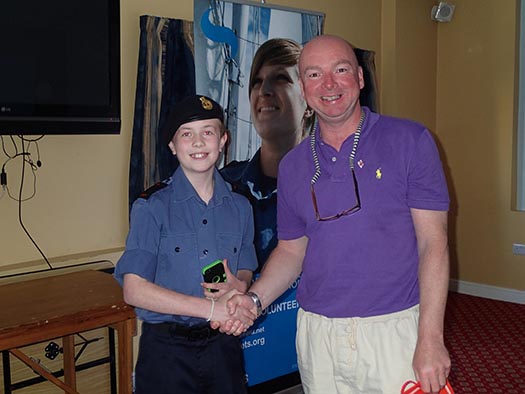
Chris Power-Smith "Aurelia" receives his prize from the Sea Cadets on the Isle of Man
"Aurleia" took Overall and Class 1. Class 2 was taken by our Isle of Man resident, Kuba Szymanski and "Polish manx". Kuba also took Silver Class.
The fleet were met by the Sea Cadets of Isle of Man who distributed a complimentary hot meal to all the crew while they waited on the Visitors Pontoons for the bridge to rise to access the Inner Harbour. The cadets also arranged a BBQ in Douglas Bay Yacht Club that evening. A special prize giving was also arranged by the cadets – the prizes had little to do with racing!!!

The 20–boat ISORA fleet moored up in Douglas
Most of the crew retired reasonably early as the fleet had to vacate the Inner harbour at 05.45 latest on Sunday morning to go to the start for the 06.35 start. A record 22 boats from the 23 entries came to the start. "Mahalar", who was to race had to pull out of the race and generously acted as Committee boat for the start.
The winds were fresh north westerly, up to 20 knots. This was looking like a "drag race" to Dun Laoghaire as the fleet blasted along the IOM coast and head to seas towards Dun Laoghaire with the ebbing tide.
"Jackknife" led the charge with "Lively Lady" behind along the coast. "Aurelia" took the alternative route, taking a more southerly course. Expectations for a fast race were dashed at Lambay island where another hole waited to trap the then weary fleet. "Jackknife", who was just a dot on the horizon for most of the race, started to get "bigger"!!! "Lively Lady", "Ruth" and "Mojito", who were some distance behind the leader, started to slow. The fleet seeing this attempted to circumnavigate the hole by heading out further to sea. All this was fruitless and the fleet stopped. This was not to be a fast race.
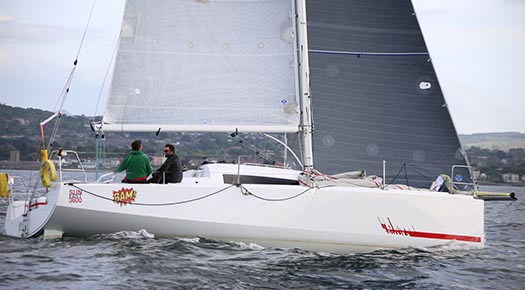
Bam from Howth arrives in Dublin Bay on Sunday evening
Zephyrs eventually started to appear and eventually "Jackknife" broke through the hole and head past Howth head to Dun Laoghaire. "Lively lady" and "Bam" were next to get going and turned into the bay only to smash into what can only be described as a "wind wall"!!! The two boats came to a sudden halt. "Bam" stopped but "Lively Lady", who was close to "Bam" at that stage, managed to keep momentum and broke through the wall. The wind on the other side of the wind wall was from a directly opposite direction.
Most of the fleet did not witness this strange wind effect. However "Sgrech" who was following did, and tried to take the same route as "Lively Lady", but to no avail as they also slammed to a halt beside "Bam". Along came "Ruth" who took a more northerly path around "Bam" and Sgrech" but again slammed into the wall. Next to attempt the wall was "Adelie" – same fate. 2-handed "Jedi " – same fate. When all chances of getting through the wall appeared to have failed, "Mojito" approached the wall and a door opened and they stalled for a brief moment, sails backed onto the opposite side and they dashed off towards the finish line. Very slowly the remaining boats made their way, tacking and gybing, towards the finish.
"Jackknife" took Overall and Class 1 while "Desert Star" took Class 2 and Silver.
All told, it was a very frustrating, sociable and enjoyable offshore racing weekend.




























